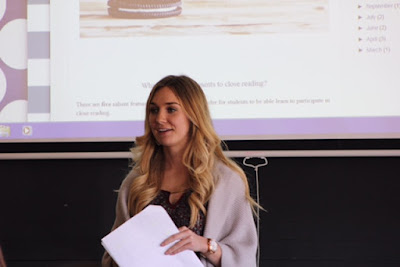The B.E.S.T Conference turned out to be so much fun and well worth all the effort and time put into having a great presentation for our peers. I'm happy I decided to take on the task of creating an engaging and informative presentation to inform future teachers about close reading and text dependent questions. I even got to collaborate with my teaching bestie for this presentation!
Here are some pictures from the conference! Thanks Casey : ) (our photographer)
Below is a picture of Macey's blog, which had an outline of our presentation. We used our blogs as a way to present our information. Everyone who attended was encouraged to bring along their own technology to the presentation so they could follow along. It's the same information that is on my previous blog post about close reading.
During our presentation we used two anchor charts that were prepared before the conference. Both of these anchor charts could be used in an actual classroom with students. We wanted everyone who came to get ideas that they could take with them into their future classrooms. I do however, recommend making the anchor charts together as a class. It's a great way to keep the students engaged and they will feel some ownership in their learning.
One anchor chart was used with our close reading Oreo activity and the other was used to understand what the different readings involve/look like in close reading. Below I have where we found both the Oreo activity and the Dig Deeper with Close Reading anchor chart.
Dig Deeper anchor chart- from Comprehension Connections
Each group around the room had a packet and caddy on their table. In the packet were graphic organizers that they could use during the presentation, along with a few other supplements to help guide their understanding of close reading. I got the awesome little whiteboards with handles on them from the Dollar Tree and they worked perfect! After we explained and gave an example of what each question would look like on the different days, we had the group members work together to formulate their own questions. When they were finished they would hold these up and we would go around the room sharing their questions. It worked really well for checking their understanding.
The last picture shown above was the closing to our presentation. We used linoit to ask the class "What Stuck With You?"
All the presenters at the B.E.S.T Conference
I loved how I had the opportunity to share in depth information on close reading that I got as a reading minor. I can't wait to continue my learning! Hopefully another opportunity like this will come again : )

































